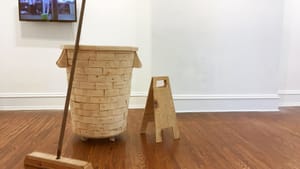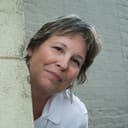Stay in the Loop
BSR publishes on a weekly schedule, with an email newsletter every Wednesday and Thursday morning. There’s no paywall, and subscribing is always free.
Timely work
Da Vinci Art Alliance presents Lucia Garzón’s ‘With Hands Like Bootsoles’

Human rights obscenities in detention centers along the southern US border occupy a big chunk of news time right now, forcing white people in America to reexamine the meaning of immigration and what our government should do with desperate people asking for asylum. So first-generation Colombian American artist Lucia Garzón’s solo exhibition, With Hands Like Bootsoles at Da Vinci Art Alliance (DVAA), comes at a particularly salient time.
“This fear”
Garzón, a Joseph Robert Foundation Artist Prize recipient, describes her work as exploring “immigration, labor, and personal identity” as an individual journey, basing her art “upon stories and experiences from my father and grandfather, who were the first in my family to navigate a new life and culture in the United States.” However, the written narrative accompanying her installation tells a more searing individual story:
"She has this fear that she has no names that she has many names that she doesn’t know her names She has this fear that she is an image that comes and goes clearing and darkening the fear that she’s the dreamwork inside someone else’s skull…"
At its best, installation art (born in the late 1960s) strives to dissolve the boundaries of “life” and “art,” taking the framed two-dimensional artistic expression off the wall and placing it in time and space, to be experienced on a more visceral level. Garzón’s work illuminates the structural social and political realities that inform some white Americans' opinions of marginalized people and subsequently shows how the dominant white culture treats or mistreats them.
On view
One part of this exhibition (whose pieces are deliberately unnamed) confronts the visitor with dirty white garments hanging on a clothesline, giving the impression that, even though washed, the immigrant laborers who wear these clothes can never get “clean” before the white gaze. It is a powerful statement of internalized shame imposed on immigrants doing the most hellish jobs.
A video of Garzón and her grandfather making janitorial items out of wood is on display along with the products of their work in the space, like a waist-high “trash can” intricately woven in oak, along with other items involved in cleaning up white folks’ messes—a duster, a spray bottle, a plunger—the rich wood communicating the lasting importance and dignity of this kind of work and the people who do it to gain entry to the American dream, trying to climb the ladder of American success.

The exhibition includes colorful t-shirt-like tops with cleaning motifs made from burlap and plastic as well as tote bags made in China but with Spanish sayings on them. The cross-cultural meanings of mixed media that Garzón does so well display the topsy-turvy syncretism indicative of the American experiment in multiculturalism.
All along one wall are white towels hanging from individual hooks. The bottom of each towel has a single word emblazoned in red stitching, which collectively form a phrase: “If my legs were longer they might carry us further.”
They won’t be erased
This exhibition tells a tale of struggling immigrants who refuse to be erased, who take pride in their heritage, and who accept that they will be “the other” in America for a time, but insist that they are real people who should not be abused or ignored. Garzón has a message that needs to be seen by everyone in this climate of immigrant child separation, refugees consigned to kennel cages for months without enough food or soap for basic cleanliness, and some current racist officials of the American government who delight in their suffering.
An earlier version of this article incorrectly stated that the pieces on display are named. They are not. It also incorrectly identified the man in the video with Garzón as her father. It is her grandfather. An earlier version of the article misstated the words visible on one of the works, which actually reads, "If my legs were longer they might carry us further." BSR regrets these errors.
What, When, Where
With Hands Like Bootsoles. By Lucia Garzón. Through July 28, 2019, at Da Vinci Art Alliance, 704 Catherine Street, Philadelphia. (215) 550-1446 or davinciartalliance.org.
Sign up for our newsletter
All of the week's new articles, all in one place. Sign up for the free weekly BSR newsletters, and don't miss a conversation.

 Suzanne Cloud
Suzanne Cloud